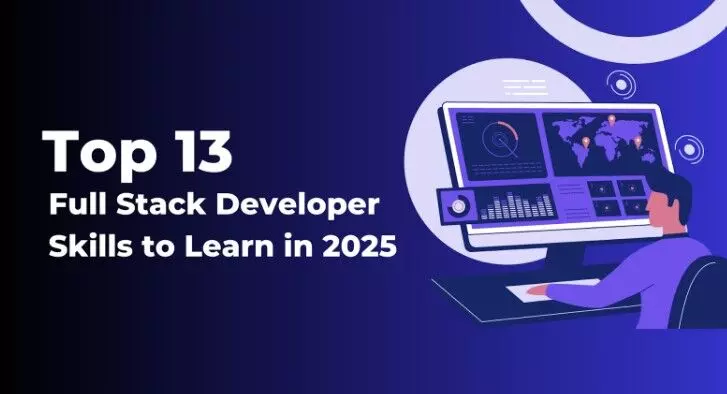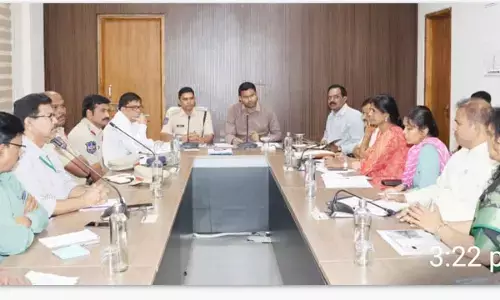Top 13 Full Stack Developer Skills to Learn in 2025

Full Stack Development has become a key skill with high demand in the 21st century. Companies want developers who can handle both the front-end and back-end of web applications, making Full Stack skills incredibly valuable. For students looking to enter into the IT industry, mastering these skills opens up a wide range of career opportunities.
Full Stack Developers can build complete, functional apps from scratch to deployment, making them essential to any technical team. Whether you're aiming for a startup or a large tech company, Full Stack Development is a path that can lead to exciting and rewarding careers. In this article, we will explore the essential Full Stack Developer Skills required to thrive in 2025.
Essential Full Stack Developers Skills to Master
Here are the essential skills a full-stack developer must possess:
1. HTML & CSS
HTML (Hypertext Markup Language) is a foundational technology used to structure content on the web. As a full-stack developer, you should be proficient in advanced HTML techniques, as they are essential for creating the layout of a website or application.
CSS (Cascading Style Sheets) works alongside HTML to define the appearance of a website, including elements like colors, fonts, and layout. Together, HTML and CSS create a rich and visually appealing user experience, and it’s crucial to understand how to use CSS effectively to style and position HTML elements.
2. JavaScript
JavaScript is a lightweight, interpreted programming language that is essential for building dynamic and interactive web pages. It's one of the most popular programming languages in the world and is used by nearly every website to enhance user engagement. JavaScript enables developers to create web applications that respond to user actions in real time.
For a full-stack developer, mastering JavaScript is vital, as it is commonly used on both the front-end (client-side) and back-end (server-side) of web applications.
3. Front-End Frameworks
Frameworks provide reusable components and structure to streamline development and make your code more maintainable. For front-end development, it’s important to learn popular frameworks that enhance productivity and code organization. Some of the most widely used front-end frameworks include React, Angular, and Vue.js. These frameworks help structure your web applications, ensuring that they are scalable and maintainable while reducing the complexity of your code.
4. Understanding Operating Systems
A strong foundation in operating systems is crucial when developing software. Full-stack developers should have a solid understanding of how different operating systems function, especially since your applications will run on these platforms.
The types of Operating Systems include Linux, macOS, and Windows. Familiarity with operating systems helps ensure that your software runs smoothly across different platforms.
5. Back-End Programming Languages
While front-end languages like HTML, CSS, and JavaScript are critical for the user interface, back-end development requires proficiency in programming languages that handle the server-side logic. A full-stack developer should be comfortable with at least one of the following back-end languages and their associated frameworks such as Java with Spring Boot, C# with .NET, and Python with Django. Choosing the right language and framework depends on the project requirements, scalability, and team preferences.
6. Version Control Systems (VCS)
Version control systems (VCS) allow developers to track changes, collaborate on code, and manage project versions. As a full-stack developer, you must be proficient with VCS tools, such as Git, GitHub, GitLab, and Apache Subversion. These tools are crucial for managing codebases and coordinating with other developers.
7. Database Knowledge
Understanding how data is stored, retrieved, and manipulated is essential for any back-end developer. Full-stack developers must be proficient in database management and know how to write complex queries. There are two main types of databases you’ll encounter:
Relational Databases: SQL, MySQL, PostgreSQL
Non-Relational Databases: MongoDB, Cassandra, NoSQL
Familiarity with both relational and non-relational databases will allow you to design effective data storage solutions.
8. API Knowledge
APIs (Application Programming Interfaces) are essential for enabling communication between different parts of a software application or with external services. Full-stack developers need to understand how APIs work and how to integrate them into their projects. Common API protocols include JSON, SOAP, Firebase, and Spring Boot (for Java). APIs are crucial for both front-end and back-end development, enabling seamless interaction between client and server.
9. HTTP & REST for Web Communication
HTTP (Hypertext Transfer Protocol) is the foundation of web communication, allowing clients (browsers) and servers to exchange data. A solid understanding of HTTP requests and responses is critical for a full-stack developer. Similarly, REST (Representational State Transfer) is a design architecture that simplifies web communication, enabling different systems to interact smoothly.
Being proficient in both HTTP and REST is essential for building robust, scalable web applications.
10. Software Testing
Ensuring your software is bug-free and performs as expected is a vital part of the development process. Back-end testing involves verifying that the server-side components of an application work correctly, ensuring data integrity and preventing crashes or data loss. Full-stack developers should be familiar with various testing types such as Structural Testing, Functional, Testing, and Non-Functional Testing. It helps maintain the quality of your applications and ensures they perform under different conditions.
11. Architecture & Design Patterns
As a full-stack developer, you need to understand how to structure your code and design patterns to create scalable, maintainable applications. Familiarity with software architecture and design principles ensures that your application is easy to manage and extend.
Understanding patterns like MVC (Model-View-Controller) or MVVM (Model-View-ViewModel) will help you organize your code efficiently and handle user interactions effectively.
12. DevOps Practices
Understanding the principles of DevOps is essential for modern development. DevOps tools like Jenkins, CircleCI, and Travis CI allow developers to automate testing, integration, and deployment.
13. Soft Skills
In addition to technical skills, Full Stack Developers should also have strong soft skills to work effectively in teams and manage projects.
Problem-Solving Skills: Developers need to be able to break down complex problems and come up with effective, scalable solutions.
Time Management: Managing multiple tasks and meeting deadlines is essential in a fast-paced development environment.
Communication Skills: Clear communication is critical when working with clients, team members, and stakeholders. Full Stack Developers need to explain technical details to non-technical audiences and collaborate with cross-functional teams.
Attention to Detail: Being detail-oriented helps developers spot bugs, prevent errors, and create optimized, efficient code.
Adaptability: The tech industry is constantly evolving, and developers must be able to quickly learn and adapt to new tools, languages, and frameworks.
Conclusion
In conclusion, full-stack developer skills are essential for building robust, scalable, and efficient web applications. These developers are proficient in both front-end and back-end technologies, including HTML, CSS, JavaScript, and server-side frameworks like Node.js or Python. They also have experience with databases and version control. The versatility of full-stack developers allows them to handle all aspects of development, from user interface design to server management. With the demand for end-to-end development growing, mastering full-stack development provides professionals with a competitive edge in the ever-evolving tech industry.
Now don’t be intimidated by the long list of skills, the path to becoming a full-stack developer is time-consuming but it is all worth your efforts. Enroll in Nxtwave’s Full Stack Developer Course that provides a structured learning path with hands-on experience along with placement assistance to help land your dream job.
Frequently Asked Questions
1. What are the most important Full Stack Developer Skills for 2024?
The key Full Stack Developer Skills for 2024 include proficiency in front-end technologies (HTML, CSS, JavaScript), back-end development (Node.js, Python, Java), database management (SQL, NoSQL), version control (Git), and DevOps practices. Responsive design and security knowledge are also essential.
2. How does JavaScript fit into Full Stack Development?
JavaScript is used both for building interactive front-end interfaces and for back-end development with frameworks like Node.js. A Full Stack Developer can use JavaScript across the entire tech stack, making it a versatile language for full-stack development.
















